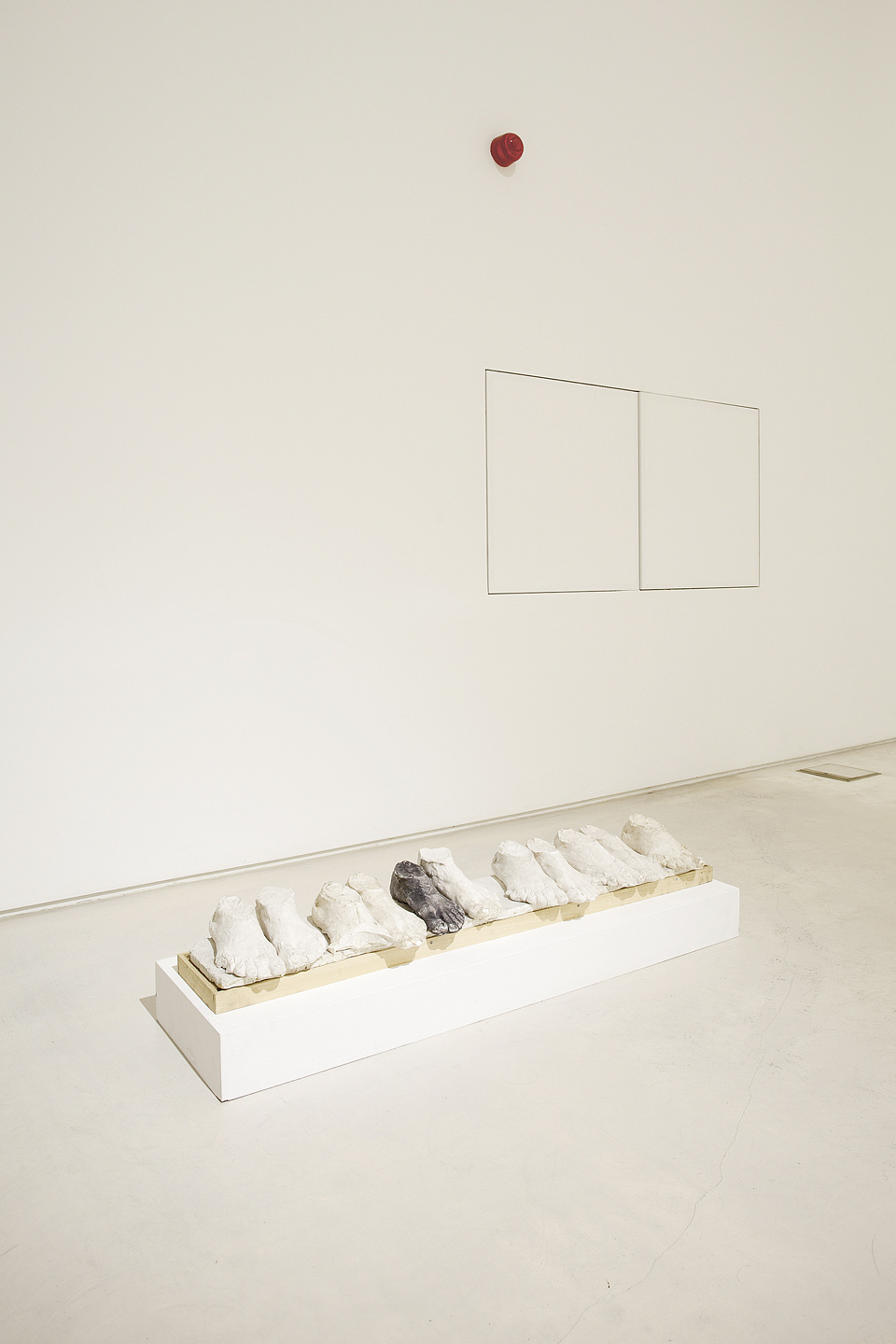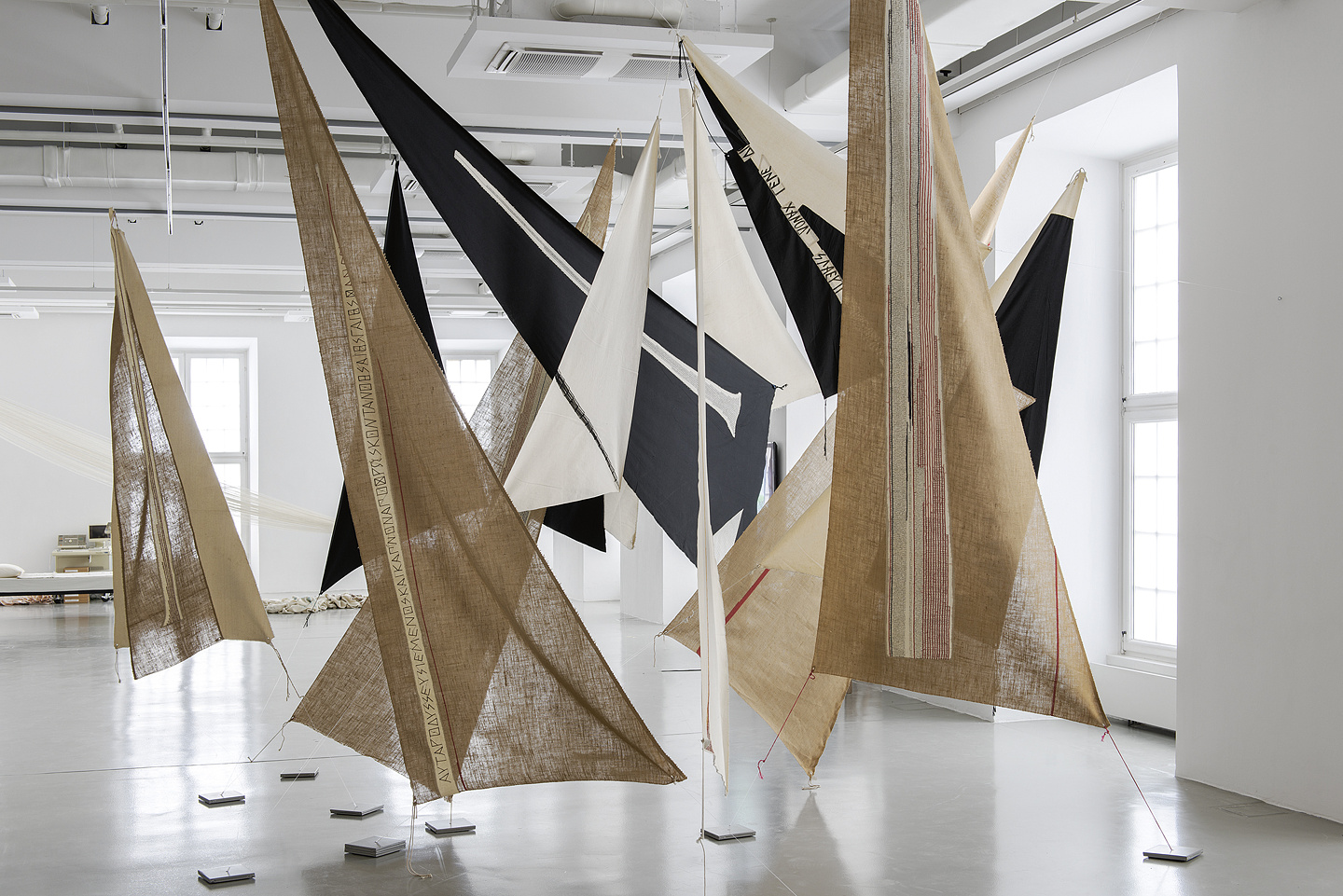Domenick Ammirati: We’re meeting here, today, in Kassel, on day 50 of documenta, the midpoint of the traditional 100 days. Or, rather, the usual midpoint: on this day we’re halfway through the Athens iteration of documenta 14, with the Kassel part of the exhibition opening in just a few weeks. All of which is to say that the circumstances of our meeting for this conversation reflect something of the dislocations of time and place, temporality and site, that are encoded in documenta 14’s DNA—its spliced DNA, if you will.
Double Gambit: Katerina Koskina and Adam Szymczyk in Conversation with Domenick Ammirati
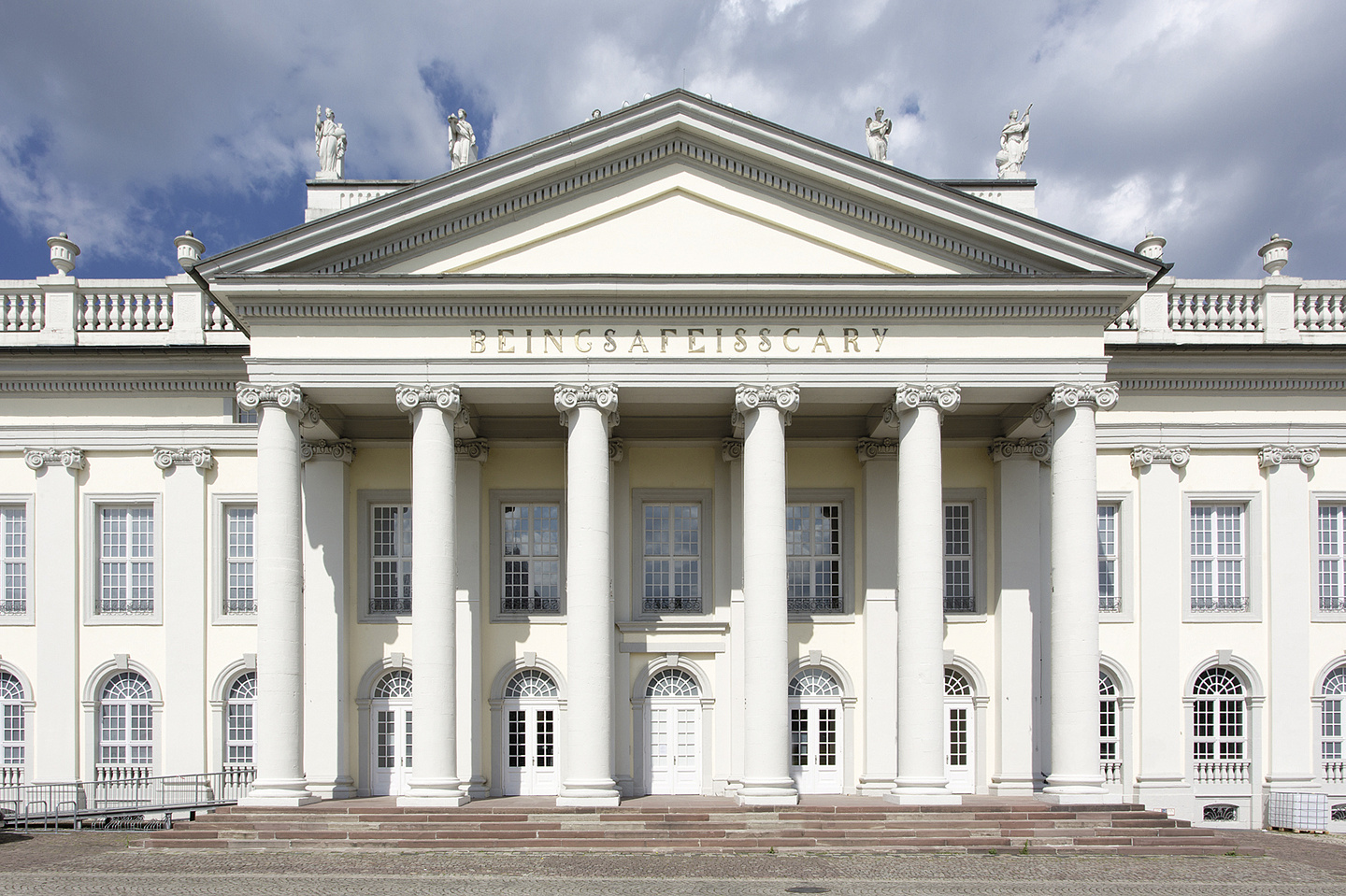
Banu Cennetoğlu, BEINGSAFEISSCARY (2017), ten aluminum letters borrowed from the Fridericianum and six letters cast in brass after the existing ones, based on graffiti existing on a wall at the National Technical University of Athens as of April 6, 2017. Coproduced with Kunstgiesserei St. Gallen, Sitterwerk, Switzerland. Installation view, documenta 14, Fridericianum, Kassel, 2017
The collaboration between documenta 14 and the National Museum of Contemporary Art, Athens (EMST) seemed both inevitable and unlikely. But no more unlikely than documenta 14 dividing like a replicating cell and moving half of itself from Germany to Greece. documenta 14 Artistic Director Adam Szymczyk’s persistent emphasis on collaborating with public institutions in the Greek iteration made EMST perhaps the preeminent possible partner in such an alliance. Despite the historical mismatch between the behemoth German institution, founded by Arnold Bode in Kassel in 1955, and the fledging Greek one, founded in 2000 and until recently housed in a temporary space at the Athens Conservatoire, EMST was nevertheless the most prominent public institution of contemporary art in Greece. It houses a collection of more than 1,100 artworks in a new, large home in the former FIX brewery in central Athens. The major problem, however, was that the permanent museum had never opened its doors: its scheduled inauguration had been derailed, like much else, by the financial crisis.
After lengthy discussions between EMST’s director, Katerina Koskina, a curator and museologist, and Szymczyk, EMST and documenta agreed to work together on important parts of documenta 14—and not only in Athens but in Kassel as well. EMST’s home in the FIX building in Athens would host the most sweeping curatorial statement in the exhibition. For its part, EMST would stage an exhibition in the Fridericianum in Kassel, the traditional and symbolic home of every documenta. It was decided, under Koskina’s guidance, that this would be a version of the show that had been planned to inaugurate the EMST building in Athens. This initial statement of the museum, via its exhibition in Kassel, would take up themes of politics and authoritarianism, mythology and migration (geographic, aesthetic, and otherwise), and forms of interiority and other subjects all readily discerned as part of Greek historical and contemporary contexts, but ramified by the international ambit of the works, the gambit of their displacement, and all that is signified by the occupancy of documenta’s Hessian home by a Greek national collection.
Amid the installation of documenta 14—and EMST—in Kassel, Koskina and Szymczyk managed to take a break from their thoroughly busy schedules and sit down for a conversation in May 2017 in the Fridericianum, surrounded by contemporary artworks from the Greek collection regularly housed, but mostly still unseen, in Athens—yet another moment of striking dislocation in a season full of them.
—Domenick Ammirati
Adam Szymczyk: I think we have reached the point where speaking from the position of only one place has become, to a degree, irrelevant. We have to acknowledge the fundamental nature of the conditions of shift and movement—mobility that is not only the “creative” mobility enabled by money at various ends of the scale, down through cheap airline tickets, but also the forced mobility of displacement and migration, especially with the new wars and the refugees seeking to enter Western Europe through Southern Europe. It was therefore becoming absolutely pertinent to sever this relationship with one place, Kassel, on a symbolic and practical level, and to do an exhibition in a way that is situated both in two places and nowhere, in the kind of nonspace that exists between the two places, contained within the time arc of 163 days between the opening in Athens and closing in Kassel.
On the other hand, it was important to look very specifically into the historical and ideological formation of the exhibition, into the genealogy or the political DNA of documenta—at what kind of enterprise it is today and where it is coming from. So our interest here was twofold. On the one hand we performed this journey, or split, or whatever you might like to call it. On the other hand we were very keen on understanding why documenta persists in a place like Kassel today, as well as exploring the forces and desires that make it continue. Today, you wouldn’t think of establishing a documenta, meaning an international exhibition of this ambition and scope, in a German city of 200,000, in Thuringia or elsewhere away from the center.
Katerina Koskina: Actually, if I am not wrong, there were more attempts at the end of the twentieth century to establish this type of international exhibition with a very strong social and political goal. In the 1990s, two curators started a very promising project in Thuringia, called Configura, which took place in Erfurt, a city in eastern Germany even smaller than Kassel. It began in 1991, very soon after the fall of the Berlin Wall. I participated, as one of five curators, in its second edition, Configura 2, in 1995. The exhibition spread out all over the town: schools, squares, wherever, with the work divided into continents. The idea was to address that unresolved historical moment. Although it was not comparable to documenta, the vision had something in common.
documenta 14 is definitely a huge and different endeavor. To double it is to complicate it; spreading it into two countries needs a lot of courage and strength. Especially when its budget is not doubled. The affinity of Athens with documenta 14’s aims has been quite clear for me from the beginning. This is why instead of just hosting documenta 14 in our temporary exhibition space we finally opted for an essential cooperation, despite our different scopes and mission.
That said, I do not accept the idea of cultural DNA. The idea of Greekness for me is something I do not understand very well. The term Greekness usually represents a certain kind of cultural conservatism, a fixed relation with a glorious past. If I could speak about one Greek characteristic, I would mention a view that has to do with constant motion and eternal migration through shifting diasporic centers. Greeks had to travel thoughout the ages, and the same goes for the artists.
Although art in Greece remained largely conservative till the end of the twentieth century, at the same time, the situation regarding contemporary art was quite ambiguous. Some of the most important Greek entrepreneurs, like Dakis Joannou and later Dimitris Daskalopoulos, were and still are among the most important collectors in the world. Therefore many important artists have been traveling and exhibiting in Greece since the 1980s because of Joannou’s collaboration with the Cypriot cultural organization House of Cyprus, in which he used to present exhibitions and projects of the Deste Foundation for Contemporary Art. Jeff Koons, Robert Gober, and others often visited Athens when they were relatively unknown; Jeffrey Deitch curated the Post Human show for Deste in 1992. Cutting-edge art has therefore been exhibited in Greece for decades, often appearing there first. However, due to an absence of public institutions and artistic education, in my opinion, this consisted of a parallel activity that did not affect or involve Greek artistic production and was often forgotten soon afterwards. This was until 2000, when public institutions, like EMST and the State Museum of Contemporary Art, Thessaloniki (SMCA) were founded, followed by important initiatives from the private sector. In any case, the current documenta is the first major international event that has instigated such involvement of the Athenian public.
AS I think nowadays we are facing something like an integrated global network of the art world. Most of the chief players in the actually existing art world are part of this global network but are not bound to specific places of production. Rather they are bound to places of representation and to where the business is eventually made. And the business is distributed, done all over the place, dislocated. We are talking about the art world now, and this is a sideline, but you can see in it how these sorts of transnational businesses function as a largely unregulated market operating across state borders, as a sort of extrastatecraft, to borrow a term from architect and writer Keller Easterling. She has written about the power of global infrastructure as an “operating system” of the modern world, with its free economic zones, cargo terminals, and exterritorial storage facilities. Though the contemporary art world’s “product” may be akin to that of a luxury industry—and hence the frequent alliances between the two—still its organization and economy resembles that of global infrastructure, governed by the “logic of operations.”
One can trace fascinating routes in terms of the economic interest that impels travel—and documenta, though much smaller than many other types of economic players, is now one of these interests. For centuries, especially in the nineteenth and the early twentieth centuries, Asia Minor and the whole basin of the Mediterranean was a place of frenetic traveling by families and businesses that were established in places like Constantinople, Alexandria, Odessa, and so forth. This history can be, of course, romanticized, via ideas of curiosity and discovery. For example, the Sikiarides family, the great Mediterranean traders of the nineteenth and twentieth centuries, organized a new business of selling second-hand hats from Manchester to Istanbul after Kemal Atatürk came to power and decided to ban the fez. Coincidentally or not, the site and buildings of their Athenian textile factory became the government’s property when Sikiaridis went out of business and were given to the Athens School of Fine Arts in 1992. Seemingly paradoxical, the history of trade and industry allows us to understand the current predicament quite precisely.
DA By taking these positions you both hold, of rejecting a kind of centeredness or fixed identity and accepting transit as a fundamental condition, I would think that you both run contrary to some of the imperatives of your respective institutions, imperatives one might call conservative. Katerina, as the director of the National Museum of Contemporary Art for Greece, you must face some people—and you alluded to this already—who believe in a different kind of mission for the institution that’s strongly focused on Greece. And Adam, you’ve taken documenta, the pride of the German art world, and moved it outside the country, at least partially. Do you both feel that you have had to take a paradoxically anti-institutional position or a subversive position within the institutions you lead?
KK First, I will say this: although the aim of EMST is not to showcase Greek art production, there is also a duty for the director of a national museum, a moral and institutional duty, to offer visibility to artists—Greek artists, mainly—who, for reasons often beyond their control, have been isolated for years. So taking that as a fact, of course the foundation of a museum in Athens has to offer this possibility. At the same time, in my position as a director, I also have to be quite resistant and unsentimental in order to try, in the late 2010s, with intense political, economic, and historical tensions coming to bear, to decide what art should be presented and exhibited.
In terms of our own collection, which began to be assembled in 2000—it is not something that just started today, or even recently—I cannot see it limited to only what is happening in Greece today. It is not a collection of the Greek contemporary art scene. It is an international collection, belonging to the National Museum of Contemporary Art of Greece. And so issues that have troubled the Greek history of art, like the so-called Greekness and other tendencies, are not prominent in the collection and its presentation, which is international in its essence. Of course we want to investigate the relation of the local with the global and the past with the present.
AS The question is: Why would one feel compelled to go against the grain of those institutional imperatives, instead of thinking about the potential of institutions to change and make change happen? Part of the idea of doing documenta 14 in Athens has been, for me, not to realize it according to some predetermined scenario in which certain institutions that I designated in advance would play a role—it was not just about filling the blanks and getting to some kind of full picture that I had in the beginning. Rather, from the start, I’ve been interested in creating a generative and transformative grammar for the entire exhibition in the Athens part of the project, thus shaping both parts, Athens and Kassel, through what we called “Learning from Athens.”
documenta was born in the specific historical and political conditions of the onset of the Cold War and the beginning of the reconstruction of Europe, largely through the Marshall Plan. So in creating our brief, we tried to situate documenta within the field of economic forces. documenta was born from a historically specific and geopolitically precisely located idea in which, I would say, the founder of documenta, Arnold Bode, wanted among other things to gather what remained of German progressive art and what could become a new German progressive art into an exhibition together with international modern art, the art the Nazis termed “degenerate,” in a place that was not very big or famous, and completely destroyed, which was Kassel. At the same time, he also wanted to draw on the formative experience of avant-garde art that he was part of in the 1920s and early ’30s in Kassel itself, as an artist and co-organizer of exhibitions of modern art with the Kassel Secession. So documenta was, from the beginning, an initiative with a local aim that gestured outward—Bode coming from the tradition of Bildung and the larger project of the education of society—to a possible “outside” of Kassel, no less than trying to work with the city’s genius loci.
Moreover, the position of documenta being a German endeavor long ago became insufficient. This was proved through the expanding scope of the exhibition during all editions of documenta in the 1970s, starting with Harald Szeemann, then through Catherine David and Okwui Enwezor rewriting history along global lines in 1997 and 2002.
DA But after taking this next logical step in the trajectory you’re describing, do you think the show can go back to being in just one place, over and over? Have you in some sense “broken” documenta?
KK I do not think he has broken anything. He has upgraded it. He has given it another perspective. It’s not to say that there was no perspective before. It’s rather that the world has changed, a lot, and everything has to evolve. Major art events have to evolve. By just confirming the importance of an event that has already proven itself, I do not see what more we bring to our world and our needs. “OK, great, we can just organize an important exhibition with major names every five years,” et cetera. But are the conditions now the same as they once were? No, they are not, in my opinion. Are the main issues having to do with gender, with population, with culture, with economics, with whatever—are they the same? No. Everything is undergoing transformation. It is an emergency to realize that and act accordingly. We need alternatives. We need another point of view. This is something we deeply understand at EMST. It is no accident that our first exhibition in the new building was titled Urgent Conversations.
AS The chance here was to try to perform a kind of emergency exit or emergency maneuver with a decision that seemed just colossal within the fairly rigid dispositif of Germany’s cultural enterprises. Within the cultural field and specifically within contemporary art, documenta is a big thing to pull somewhere—it takes enormous energy. You have to delegate your responsibilities to many people and make with them a common effort to push through and try to do something differently. Even then you run the risk that politics and institutional inertia will pull you back into a received model of operation. So the challenge is indeed to revise and transform the received formats and ways of being and making that seem to be losing their relevance—those related to essentializing the importance of the “original” site of documenta, its “belonging” to one place, its ambition to observe, absorb influences, and pass judgments rather than to directly engage, and so on. I believe we managed to call these very habits into question.
As cultural producers, we must think again and again about the concept of art’s social function and the position of artists in society. I believe there is a way of reconfiguring the role of a large exhibition. About the most interesting thing about documenta is that it might be used as a tool and not just repeated as a model.
KK I strongly believe that art cannot give recipes, but it can show alternative ways to reach points that are not limited to culture. The decision to bring documenta to another place is a decision to enlarge the meaning of art and also the meaning of the organization. I do not feel that by splitting it with another city in Greece or elsewhere you diminish it. You are accepting a fact, the fact that Germany, or Europe, or the world, is not the same anymore. This is also urgent, to first understand the situation in order to be able to handle it. And Athens today embodies almost all the dilemmas of Europe and of the Mediterranean region: financial crisis, refugees, social destabilization, political uncertainty.
AS It’s like we are witnessing the possibility that official politics can become completely irrelevant to the people. The credibility and legitimization based solely on votes received seem to be no longer sufficient, which is very dangerous, because you have all kinds of populists who might profit—they can still build a solid base for such representation. They will keep trying to take over, in order to then change the very rules that brought them to power, as seen in Turkey, Poland, the United States, and elsewhere.
The question is: What kind of other formula of political participation can emerge, one that does not aim to represent the nation but tries to self-organize things on the ground so that people can live their lives in a city like Athens, and in other cities? Greece is also a place where people have taken things into their own hands out of necessity, now for ten years already in the current predicament of economic downfall and austerity measures. This kind of contrarian attitude is producing enormously rich and very important grassroots political responses to the fallacies of the official politics that are, first, too slow to shift; second, maybe too conservative in their basic construction; and third, totally dependent on the kind of global setup that pushes forward well-known scenarios of memoranda, capital controls, and other “instruments” of politics based on the sheer economic power of the “strong” countries over the “weak.”
DA You’re both very sensitive to language. The working title of documenta 14, “Learning from Athens,” is an example of capturing a complex proposition in a simple phrase. For your part, Katerina, could you talk a little bit about the titling of the EMST collection presentation at the Fridericianum?
KK The title that we initially thought of using was the Greek word antidaneio. The meaning is, basically, a loan that is given back, something that has been loaned and then returned. It is a term that is mainly used in literature and in architecture. For example, the city of Munich was built based on ancient Greek architectural principles and, later, at the beginning of the nineteenth century, the city of Athens, as the capital of the modern Greek state, was built following Munich’s example, designed by German architects. So these are loans, mutual loans. I would have loved to use this as the title of the exhibition, but the problem is that if I literally translate it into English, and maybe into German, it becomes very financial and alludes to war reparations, i.e., the money that the Greek government could, or should, ask the German government to return. I do not believe it would be wrong to switch the interest from cultural issues to the financial, but another possible title might be the word antidoron, which is a gift in return, and which in Greek Orthodox tradition carries also the meaning of sacrifice and Holy Communion as well as with sharing matter and spirit.
AS The term antidaneio is interesting, because it is used in different fields or areas. The use of the term in linguistics translates into “reborrowing,” right? I believe also that it has become a term in contemporary economics, maybe even a term that might be related to the current debt payments—because money from the “institutions” flows into Greece and then it flows back out to the original lenders via banks. So you have again this kind of movement, in which there is a payment but then there is an immediate return on this payment to the source from which it’s come.
KK As a title, it captivates immediately—you have an immediate reaction. But I don’t know. My curators and I have to discuss it. For me, and I hope for Adam and the rest of our friends at documenta, this cooperation is an antidaneio, or even better an antidoron. We say in ancient Greek, δούδο δούνε λαβείν. You give me; I give you. It is an equal position, although sometimes people are not equal—because you cannot compare EMST with documenta, generally speaking. But in a commitment like this you have to be able to converse in equal terms.
DA It’s important to again underscore that the show you’re presenting at the Fridericianum, Katerina, is actually the show you had planned to be the debut show for the collection in Athens—in a sense, EMST is presenting its inaugural show in Kassel. It’s a rich gesture that implicates not just the institutions but the architectures as well.
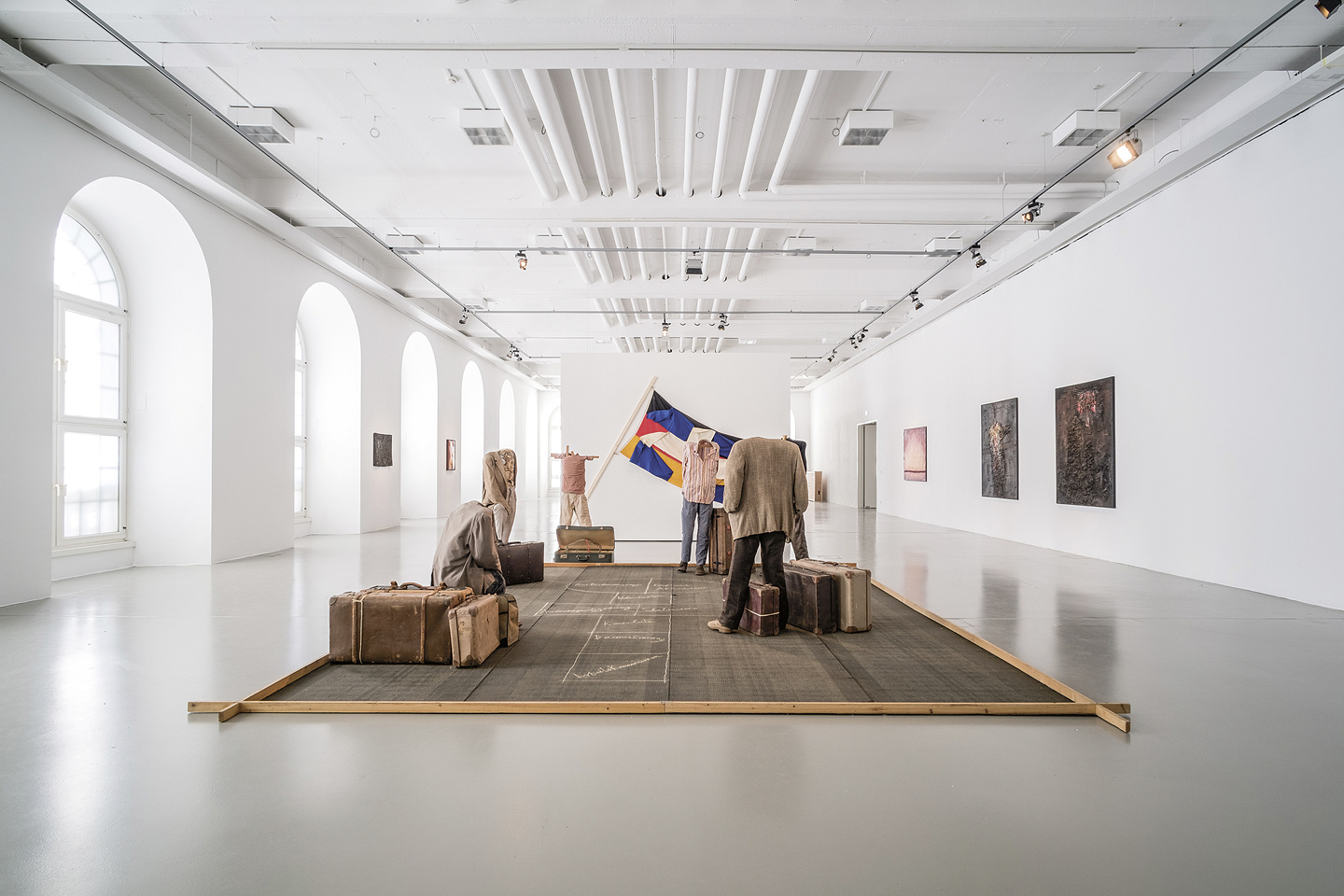
Vlassis Caniaris, Hopscotch (1974), six human figures (chicken wire over wooden frame, paper and plastic filling, and used clothes), nine suitcases, metal birdcage, and chalk on tar paper. National Museum of Contemporary Art, Athens (EMST). Installation view, documenta 14, Fridericianum, Kassel, 2017
KK What is happening here is that we are bringing to Kassel a version of the museological study that the director of a museum in Greece has to submit to the council of museums when a museum opens for the first time. This study was for an exhibition that should describe more or less the path of contemporary art viewed in the country through the eyes of the Greeks mainly from the 1960s to now. This is not always easy, because if you ask people’s opinions, everybody will expect you to showcase all the works of the contemporary Greek artists that didn’t have the opportunity to be exhibited in their time. So, what I had to do, first, was to convince everybody that that does not interest anybody. The collection has to be seen according to what is happening both in Greece and in the world: in the arts, the economy, politics, society, technology, et cetera. Of course, at the same time, I had to prioritize the Greek artists—it is EMST’s institutional responsibility to add Greek voices to a global dialogue.
I decided to approach this by addressing three general topics: one that has to do with politics, related mainly to the period of dictatorship in Greece and after; then, second, crossing borders in a broad sense—not only literal borders, barriers, in terms of migration and travel but also borders within art, in ways that have to do with formalistic achievements sometimes, or with ideas, or with gender, or with many other aspects. Then, last but not least: there is the inner self, mythology, interior space. In my opinion this interiority, beyond its relationship to psychology and literature, is also closely related to tradition.
So, in Kassel, when it was decided to present an exhibition in the Fridericianum, my thought was: Why not anticipate the opening of EMST’s permanent exhibition at the Fridericianum itself? This would offer a larger symbolic value to our cooperation, while at the same time would be in keeping with our program “EMST in the World,” our strategic plan for collection and institutional mobility, which began a few months ago with our collaboration with the Museum of Contemporary Art, Antwerp. So instead of proposing another exhibition, I thought to bring the museological study, which has been approved to be implemented for EMST in Athens, to the Fridericianum. This would be more adequate. So, with the support of EMST curators Tina Pandi and Stamatis Schizakis and EMST architect Iro Nikolakea, we investigated how to adjust the study to the conditions of the Fridericianum, conceptually and architecturally.
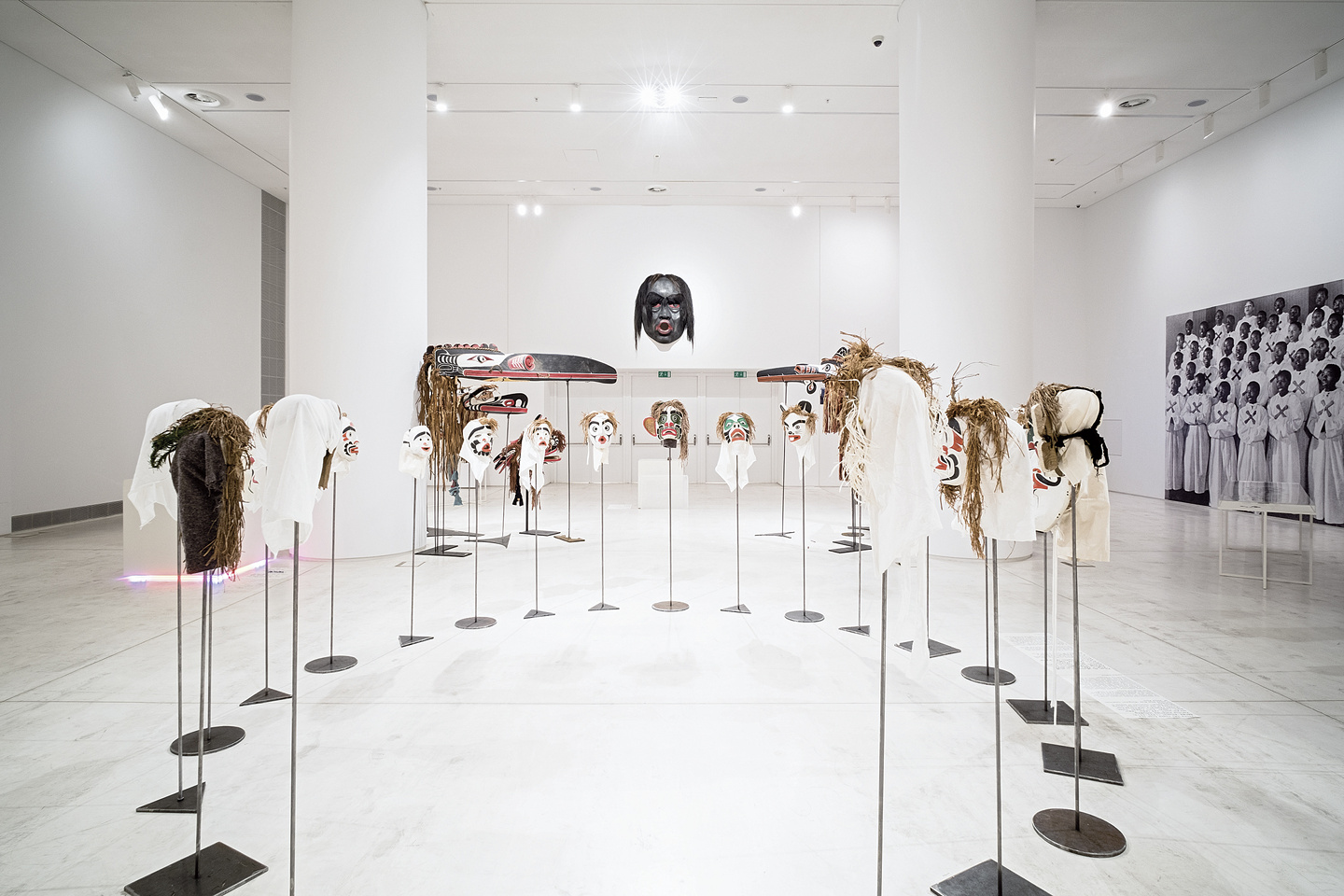
Beau Dick, masks from the series “Atlakim” (1990–2012) and “Undersea Kingdom” (2016–17), Crooked Beak masks (ca. 2000), and Raven masks (ca. 2000), and Tsonoqua Mask (2016). Rear right: Sammy Baloji, Tales of the Copper Cross Garden: Episode I (2017), video, photographs, copperplate, copper crosses, and coins. Installation view, documenta 14, National Museum of Contemporary Art, Athens (EMST), 2017
AS At the moment that Katerina became convinced the collaboration with documenta should happen, EMST had to do in an extremely short time an enormous amount of political, administrative, and practical work with a small team. I know it was difficult work for the museum. We could not be too involved at that stage in the matters of Greek art as well as administrative matters—but we could support the process from the moment it was about to become the exhibition as part of documenta 14 in Kassel, which in the meantime we were also working on. I think for EMST it was a tremendous effort that is continuing, and I hope that you, Katerina, feel that the effort has been toward something that has a sound logic and will fully materialize through the opening of the museum to the public in Athens as soon as possible. And I hope that the relevant Greek authorities will embrace this task and work toward the achievement of making EMST fully public.
KK Contemporary culture in Greece has been a neglected issue. And because of documenta 14—even if the audience is pro- or anti-documenta for their own reasons—something very important has happened: everybody, for or against, has spent time discussing and criticizing contemporary art. In fewer than two months, the main subjects of public conversation, in social media, have changed to include contemporary art, even if people who are spending time discussing it have no idea about it. But they are there; they are part of the mosaic. It is a new field we have opened, and this is very important. And everybody knows, from the president of the republic to a taxi driver, that in this very place where they grew up, in Athens, there is a museum of contemporary art. And with the show we installed in Kassel, we gave ourselves the task of addressing questions such as: What does Kassel represent for the art world? What does the audience expect to see in Kassel from the national museum of a country that has not started to fully operate yet? I think our strategy is exactly what made the project fit with documenta 14’s title and the decision to “learn from Athens”—whatever that “learning” means.
AS The call for learning from others, at least as I intended it, has to do with a hospitality without preconditions, not bound to certain expectations, extending something without asking for something in return to balance your accounts. I think that the learning we have all done is exactly in that sense. It can open up a conversation that is nonhierarchical. Within this space of conversation something may happen that goes beyond the logic of political and economic supremacy, which we see is a nightmare that many are forced to live in.

